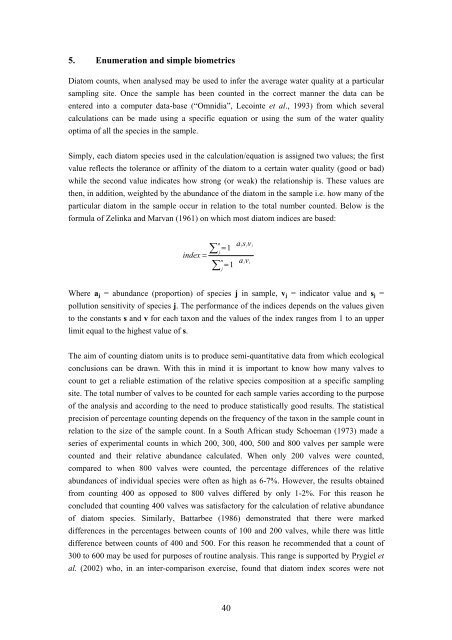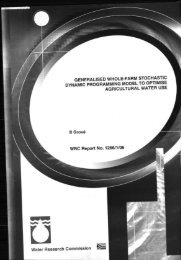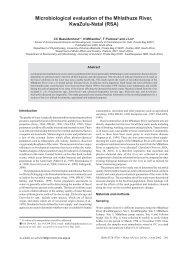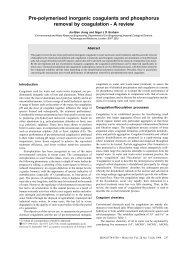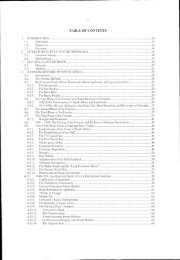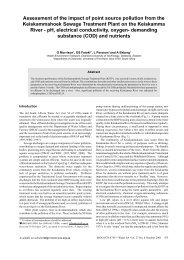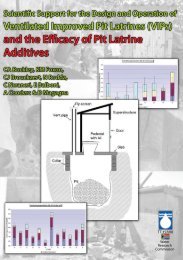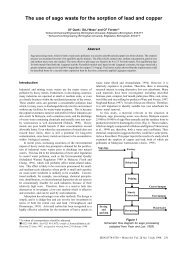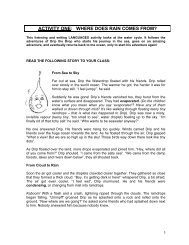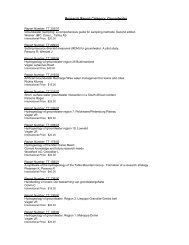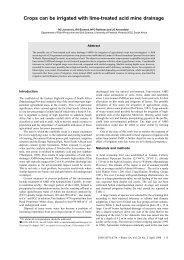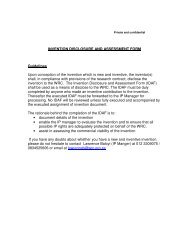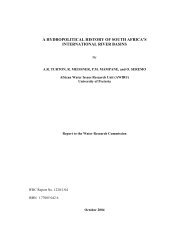A Methods Manual for the Collection, Preparation and Analysis of ...
A Methods Manual for the Collection, Preparation and Analysis of ...
A Methods Manual for the Collection, Preparation and Analysis of ...
Create successful ePaper yourself
Turn your PDF publications into a flip-book with our unique Google optimized e-Paper software.
5. Enumeration <strong>and</strong> simple biometricsDiatom counts, when analysed may be used to infer <strong>the</strong> average water quality at a particularsampling site. Once <strong>the</strong> sample has been counted in <strong>the</strong> correct manner <strong>the</strong> data can beentered into a computer data-base (“Omnidia”, Lecointe et al., 1993) from which severalcalculations can be made using a specific equation or using <strong>the</strong> sum <strong>of</strong> <strong>the</strong> water qualityoptima <strong>of</strong> all <strong>the</strong> species in <strong>the</strong> sample.Simply, each diatom species used in <strong>the</strong> calculation/equation is assigned two values; <strong>the</strong> firstvalue reflects <strong>the</strong> tolerance or affinity <strong>of</strong> <strong>the</strong> diatom to a certain water quality (good or bad)while <strong>the</strong> second value indicates how strong (or weak) <strong>the</strong> relationship is. These values are<strong>the</strong>n, in addition, weighted by <strong>the</strong> abundance <strong>of</strong> <strong>the</strong> diatom in <strong>the</strong> sample i.e. how many <strong>of</strong> <strong>the</strong>particular diatom in <strong>the</strong> sample occur in relation to <strong>the</strong> total number counted. Below is <strong>the</strong><strong>for</strong>mula <strong>of</strong> Zelinka <strong>and</strong> Marvan (1961) on which most diatom indices are based:index n∑ j∑1nj1a jsjva jvjjWhere a j = abundance (proportion) <strong>of</strong> species j in sample, v j = indicator value <strong>and</strong> s j =pollution sensitivity <strong>of</strong> species j. The per<strong>for</strong>mance <strong>of</strong> <strong>the</strong> indices depends on <strong>the</strong> values givento <strong>the</strong> constants s <strong>and</strong> v <strong>for</strong> each taxon <strong>and</strong> <strong>the</strong> values <strong>of</strong> <strong>the</strong> index ranges from 1 to an upperlimit equal to <strong>the</strong> highest value <strong>of</strong> s.The aim <strong>of</strong> counting diatom units is to produce semi-quantitative data from which ecologicalconclusions can be drawn. With this in mind it is important to know how many valves tocount to get a reliable estimation <strong>of</strong> <strong>the</strong> relative species composition at a specific samplingsite. The total number <strong>of</strong> valves to be counted <strong>for</strong> each sample varies according to <strong>the</strong> purpose<strong>of</strong> <strong>the</strong> analysis <strong>and</strong> according to <strong>the</strong> need to produce statistically good results. The statisticalprecision <strong>of</strong> percentage counting depends on <strong>the</strong> frequency <strong>of</strong> <strong>the</strong> taxon in <strong>the</strong> sample count inrelation to <strong>the</strong> size <strong>of</strong> <strong>the</strong> sample count. In a South African study Schoeman (1973) made aseries <strong>of</strong> experimental counts in which 200, 300, 400, 500 <strong>and</strong> 800 valves per sample werecounted <strong>and</strong> <strong>the</strong>ir relative abundance calculated. When only 200 valves were counted,compared to when 800 valves were counted, <strong>the</strong> percentage differences <strong>of</strong> <strong>the</strong> relativeabundances <strong>of</strong> individual species were <strong>of</strong>ten as high as 6-7%. However, <strong>the</strong> results obtainedfrom counting 400 as opposed to 800 valves differed by only 1-2%. For this reason heconcluded that counting 400 valves was satisfactory <strong>for</strong> <strong>the</strong> calculation <strong>of</strong> relative abundance<strong>of</strong> diatom species. Similarly, Battarbee (1986) demonstrated that <strong>the</strong>re were markeddifferences in <strong>the</strong> percentages between counts <strong>of</strong> 100 <strong>and</strong> 200 valves, while <strong>the</strong>re was littledifference between counts <strong>of</strong> 400 <strong>and</strong> 500. For this reason he recommended that a count <strong>of</strong>300 to 600 may be used <strong>for</strong> purposes <strong>of</strong> routine analysis. This range is supported by Prygiel etal. (2002) who, in an inter-comparison exercise, found that diatom index scores were not40


